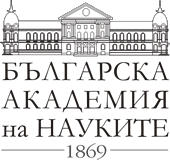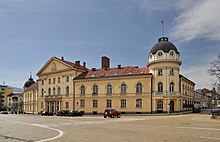Bulgarian Academy of Sciences
This article needs additional citations for verification. (March 2013) |
| Българска академия на науките | |
 Logo of Bulgarian Academy of Sciences | |
| Established | 1869 |
|---|---|
| Headquarters | Sofia, Bulgaria |
| Coordinates | 42°41′40″N 23°19′54″E / 42.69444°N 23.33167°E |
President | Yulian Revalski |
| Website | www |
 | |
The Bulgarian Academy of Sciences (abbreviated BAS; Bulgarian: Българска академия на науките, Bŭlgarska akademiya na naukite, abbreviated БАН) is the National Academy of Bulgaria, established in 1869.
The Academy, with headquarters in Sofia, is autonomous and consists of a Society of Academicians, Correspondent Members and Foreign Members. It publishes and circulates different scientific works, encyclopaedias, dictionaries and journals, and runs its own publishing house.
The activities are distributed in three main branches: Natural, mathematical and engineering sciences; Biological, medical and agrarian sciences and Social sciences, humanities and art. They are structured in 42 independent scientific institutes, and a dozen of laboratories and other sections.
Julian Revalski has been the president of the BAS since 2016. As of 2022, its budget was 119,860 million leva (€61.28 million).[1]
History
[edit]
As Bulgaria was part of the Ottoman Empire, Bulgarian émigrés founded the Bulgarian Literary Society on 26 September 1869, in Brăila in the Kingdom of Romania, on the model of the Romanian Literary Society, that had been established in 1866. The first Statutes accepted were:
Board of Trustees
Acting members:
- Marin Drinov (1838–1906) – Chairman
- Vasil Drumev (1840–1901) – Member
- Vasil D. Stoyanov (1839–1910) – Secretary
The following year, the Literary Society began issuing the Periodical Journal, its official publication, and in 1871 elected its first honorary member - Gavril Krastevich.
In 1878, shortly after Bulgaria's liberation from Ottoman rule, the General Assembly voted to move the headquarters of the Society from Brăila to Sofia, and on 1 March 1893 the BLS moved into its own building, right next to where the Bulgarian Parliament is seated. The BLS headquarters were completed in 1892. The building was designed by architect Hermann Mayer[2] and was expanded during the 1920s.[3]
The Bulgarian Literary Society adopted its present-day name in 1911, and Ivan Geshov became the Academy's first president. The BAS became a member of the Union of Slavonic Academies and Scientific Communities in 1913 and was accepted as a member of the International Council of Scientific Unions in 1931.
The BAS was awarded the Japanese Foreign Minister’s Commendation for their contributions to promotion of mutual understanding between Bulgaria and Japan on 1 December 2020.[4][5]
Departments
[edit]This article's factual accuracy may be compromised due to out-of-date information. (December 2018) |
The BAS has 9 main sections, more broadly united under three main branches: Natural, mathematical and engineering sciences; Biological, medical and agrarian sciences and Social sciences, humanities and art. Each consists of independent scientific institutes, laboratories and other sections.
Mathematical Sciences
[edit]- Institute of Mathematics and Informatics
- Institute of Mechanics
- Institute of Information and Communication Technologies
- National Laboratory of Computer Virology
Physical Sciences
[edit]- Institute for Nuclear Research and Nuclear Energy
- Institute of Solid State Physics
- Institute of Electronics
- Institute of Astronomy
- National Astronomical Observatory - Rozhen
- Astronomical Observatory Belogradchik
- Central Laboratory of Solar Energy and New Energy Sources
- Central Laboratory for Applied Physics - Plovdiv
- Central Laboratory of Optical Storage and Processing of Information
Chemical Sciences
[edit]- Institute of General and Inorganic Chemistry
- Institute of Organic Chemistry with a Centre of Phytochemistry
- Institute of Physical Chemistry
- Institute of Catalysis
- Institute of Electrochemistry and Energy Systems (IIES) (former Central Laboratory of Electrochemical Power Sources)
- Institute of Chemical Engineering
- Central Laboratory of Photoprocesses
- Institute of Polymers
Biological Sciences
[edit]- Institute of Neurobiology
- Institute of Molecular Biology
- Institute of Genetics
- Institute of Physiology
- Institute of Plant Physiology
- Institute of Microbiology
- Institute of Experimental Morphology and Anthropology
- Institute of Botany
- Institute of Zoology
- Forest Research Institute
- Institute of Experimental Pathology and Parasitology
- Institute of Biology and Immunology of Reproduction
- Institute of Biophysics and Biomedical Engineering
- National Museum of Natural History
- Central Laboratory of General Ecology
Earth Sciences
[edit]- Geological Institute
- Geophysical Institute
- National Institute of Meteorology and Hydrology
- Central Laboratory for Geodesy
- Central Laboratory of Mineralogy and Crystallography
- Institute of Oceanology
- Geographical Institute
- Space Research Institute
- Central Laboratory of Solar - Terrestrial Influences
- Central Laboratory for Seismic Mechanics and Earthquake Engineering
- Institute of Water Problems
Engineering Sciences
[edit]- Institute of Metal Science
- Central Laboratory of Physico-Chemical Mechanics
- Institute of Computer and Communication Systems
- Institute of Information Technologies
- Institute of Control and System Research
- Central Laboratory of Mechatronics and Instrumentation
- Bulgarian Ship Hydrodynamics Centre
Humanities (Division 'Cultural-Historical Heritage and National Identity')
[edit]- Institute of Bulgarian Language
- Institute of Literature
- Institute for Balkan Studies and Centre for Thracology
- Institute for History Studies
- Institute for Ethnology and Folklore Studies with Ethnographic Museum, comprising the former
- Institute for Folklore Studies
- Ethnographic Institute with Museum
- Institute for Arts Studies, comprising the former
- Centre for Architectural Studies
- Institute of Art Studies
- National Archaeological Institute and Museum
- Scientific Centre for Cyrillo-Methodian Studies
Social Sciences (Division 'Man and Society')
[edit]- Institute for Economic Studies
- Institute for the State and Law
- Institute for Population and Human Studies, comprising the former
- Institute of Psychology
- Centre for Population Studies
- Institute for the Study of Societies and Knowledge, comprising the former
- Institute of Sociology
- Institute of Philosophical Studies
- Centre for Science Studies and History of Science
Specialized and Supporting Units
[edit]- Central Administration of BAS
- Central Library of BAS
- Scientific Archives of BAS
- 'Prof. Marin Drinov' Academic Publishing House
- Botanical Garden
- National Centre on Nanoscience and Nanotechnology
- Bulgarian Encyclopaedia Scientific Information Centre
- Social - Utility Service
- Centre for National Security Research
- Research Development and Implementation Association 'Scientific Instrumentation'
- Laboratory of Telematics
- Ph.D. Research Career Development Centre
Honours
[edit]Academia Peak and Camp Academia on Livingston Island in the South Shetland Islands, Antarctica are named for the Bulgarian Academy of Sciences in appreciation of Academy's contribution to the Antarctic exploration.[6]
See also
[edit]References
[edit]- ^ "Bulgarian Academy of Sciences budget puts the institution at risk, scientists say".
- ^ Михайлова, Милена (21 June 2007). "Отново за историческата среда около храм-паметника "Св. Александър Невски"" (in Bulgarian). Арх & Арт. Archived from the original on 17 January 2013. Retrieved 30 November 2011.
- ^ Иванов, Емил. "КУЛТУРНО-ИСТОРИЧЕСКОТО НАСЛЕДСТВО НА БЪЛГАРИЯ – ОПИТ ЗА КАТЕГОРИЗАЦИЯ НА КОНКУРСНОТО ДЕЛО В АРХИТЕКТУРАТА (1878-1944)" (PDF) (in Bulgarian). СУ „Св. Климент Охридски” – Богословски факултет. Archived from the original (PDF) on 26 April 2012. Retrieved 30 November 2011.
- ^ Foreign Minister’s Commendations for FY 2020 | Ministry of Foreign Affairs of Japan
- ^ Foreign Minister’s Commendations for FY 2020 (Groups) | Ministry of Foreign Affairs of Japan
- ^ Academia Peak. Composite Gazetteer of Antarctica.
